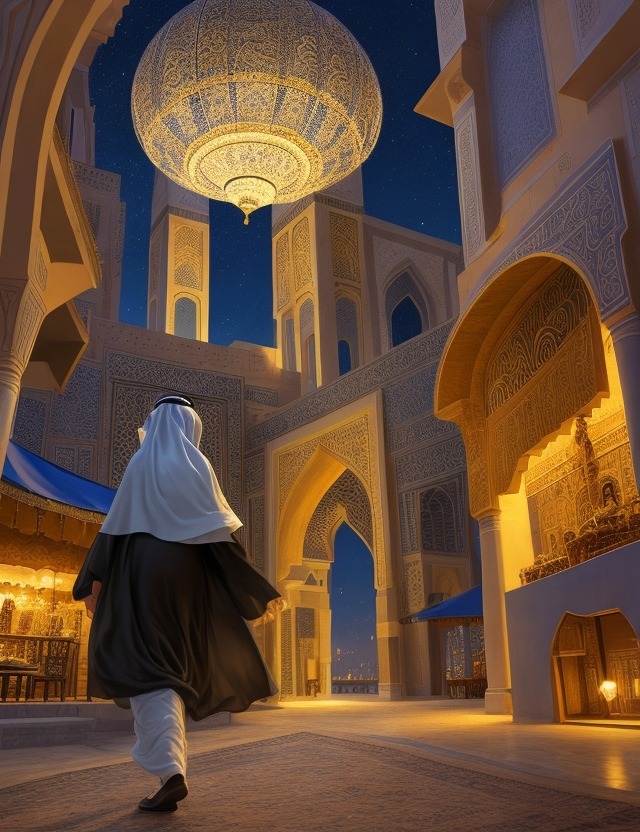Step into a realm of captivating tales, where mystique intertwines with cultural heritage, and centuries-old wisdom illuminates the human experience. In this article, we embark on a journey through the timeless masterpiece that is none other than “The Arabian Nights.” Unveiling the magic cherished by generations, this enthralling collection of stories invites you to explore a cherished tradition of oral storytelling that has endured for centuries.
From the pen of unknown authors, steeped in the rich tapestry of Arab culture, The Arabian Nights weaves a spellbinding narrative that transcends boundaries of time and space. Dating back to the Islamic Golden Age and originating from diverse regions, these tales of love, adventure, and wit have captivated readers around the globe.
Famed for its iconic characters such as Aladdin, Sinbad, and Ali Baba, The Arabian Nights has become more than a literary masterpiece – it is a cultural phenomenon that has molded our perception of the mesmerizing East. Embedded within this cherished collection lies a treasure trove of mythical creatures, forbidden romances, and moral dilemmas that continue to resonate with readers from all walks of life.
Prepare to embark on a transformative journey through the sun-drenched deserts, bustling bazaars, and mystical lands of the Arabian Peninsula, as we unravel the spellbinding tapestry of stories that has enchanted hearts since time immemorial. A triumph of imagination and cultural fusion, The Arabian Nights awaits your discovery in all its captivating glory. Let us delve into this literary treasure and unmask the essence of its enduring allure.
The Arabian Nights Story Summary
Once upon a time, in a faraway land called Arabia, there lived a young girl named Scheherazade. She was the daughter of a wise and noble king, and she possessed a keen imagination and a thirst for adventure. Scheherazade was known throughout the kingdom for her love of storytelling, and her tales were like magic, gripping the hearts of all who listened.
One day, as Scheherazade was strolling through the grand halls of the palace, she overheard a conversation between her father, the King, and his advisors. They were discussing a terrible event that had taken place in the kingdom. The King’s beloved wife, who had just given birth to their son, was found lifeless in her chambers. Grief and sorrow clouded the King’s heart, and he vowed never to love another woman again.
Scheherazade’s heart ached for her father, knowing he was consumed by sadness and needed something to fill the void left by his deceased wife. She bravely approached the King and made a startling proposal. “Father,” she said, “I will marry you, but on one condition. Allow me to tell you a story every night, for a thousand and one nights. I promise that each tale will be more fascinating than the last.”
The King was intrigued by his daughter’s condition, and his curiosity got the better of him. He agreed to her proposal with a glimmer of hope that these stories might bring solace to his wounded heart. And so, Scheherazade began her enchanting journey of storytelling, hoping that her tales would captivate her father’s heart and change his perspective on love.
On the first night, Scheherazade began to weave her spellbinding stories. She regaled the King with tales of daring princesses, cunning thieves, magical genies, and lost treasures buried deep within the deserts of Arabia. Each story was carefully crafted with vivid descriptions, suspenseful twists, and important life lessons hidden within.
The King found himself drawn into the magical realms of Scheherazade’s stories, forgetting his grief and immersing himself in the extraordinary adventures unfolding before him. Each night, as the moon rose high in the sky, Scheherazade transported her father to new lands and introduced him to characters both familiar and unknown.
Through her tales, Scheherazade showed the King the beauty of love, the power of forgiveness, and the importance of second chances. She shared stories of kindness, bravery, and the triumph of good over evil. The King’s heart began to heal, and a newfound hope bloomed within him.
As the days turned into weeks and the weeks into months, Scheherazade’s stories continued to work their magic on the King’s heart. He looked forward to each evening, eager to hear the next tale and see how it would unfold. The kingdom itself was transformed by the power of Scheherazade’s stories, as hope and joy returned to its people.
But amidst the mesmerizing tales, an unexpected story began to unfold. Scheherazade found herself falling in love with her own stories. She had dedicated herself to healing her father’s broken heart, but she never anticipated the effect her tales would have on her own soul.
One thousand and one nights came and went, and the King found himself at a crossroads. He had fallen deeply in love with Scheherazade, enchanted not only by her stories but also by her courage, wisdom, and kind heart. He realized that he could not bear to live without her, and he decided to make a heartfelt confession.
On the final night, as the moon shone its brightest, the King spoke. “My dear Scheherazade,” he began, “your tales have brought light into my life once again. But it is not only your stories that have captured my heart. It is you, my daughter. I want you to be my queen, not only for a thousand and one nights but for all eternity.”
Scheherazade’s heart swelled with love and joy as she accepted her father’s proposal. The kingdom rejoiced, knowing that their beloved princess had found her own happy ending. And so, Scheherazade’s stories became the legend of The Arabian Nights, forever etched in the hearts of children and adults alike.
As we close this book, let us remember the power of storytelling. It has the ability to heal, inspire, and transform lives. Just like Scheherazade, may we all find solace in the stories that surround us and may our own tales breathe life into our dreams and aspirations. The end.
The Arabian Nights: Key Themes
The Arabian Nights is a compilation of Middle Eastern tales and folklore, originally written in Arabic and translated into various languages. It is also known as One Thousand and One Nights, as it tells the story of a young woman named Scheherazade who tells the king a new story each night to postpone her execution. Let’s explore three key themes of this iconic book:
- The Power of Storytelling: One of the prominent themes in The Arabian Nights is the power of storytelling as a means of survival and influence. Scheherazade’s storytelling becomes a tool to captivate the king, preventing him from executing her. Through her tales, she not only entertains the king but also imparts wisdom and life lessons. This theme emphasizes the transformative and therapeutic nature of storytelling, showcasing how narratives have the power to shape our perception of the world and connect people across cultures and generations.
- The Role of Women: The Arabian Nights challenges traditional gender roles and highlights the strength and intelligence of women in a male-dominated society. Scheherazade emerges as a figure of resilience and agency, using her wit and storytelling abilities to not only save her own life but also to bring about changes in the king’s character. The overarching presence of strong female characters throughout the stories within the book, such as Shahrazad’s sister Dunyazad or the clever characters like Morgiana or Marjana, challenges the stereotypical portrayal of women in traditional narratives.
- The Duality of Human Nature: The tales in The Arabian Nights delve into the complexities of human nature, showcasing both the virtuous and the wicked sides of individuals. The characters depicted in these stories often find themselves grappling with moral dilemmas, making choices that affect their lives. The book explores themes of greed, deception, love, power, and redemption, highlighting the contrast between good and evil. Through intricate storytelling and intricate characters, The Arabian Nights reveals the multifaceted nature of humanity and encourages self-reflection and introspection.
Overall, The Arabian Nights is a literary treasure that weaves together a tapestry of stories, illustrating the power of storytelling, the agency of women, and the complexities of human nature. It continues to captivate readers worldwide with its timeless themes and enchanting narratives.
The Arabian Nights: Characters
1. Scheherazade: The intelligent and captivating storyteller who saves her life by weaving mesmerizing tales night after night. With her striking emerald eyes and flowing chestnut curls, she possesses an air of mystery and a voice that can command the attention of anyone. She wields her wit and imagination like a sword, impressing even the most stoic of listeners. Scheherazade possesses an uncanny ability to find humor in the darkest of situations, and her laughter is as enchanting as her stories.
2. Aladdin: A mischievous young street urchin with a heart of gold. Aladdin’s lustrous ebony hair and sparkling sapphire eyes make him the most desirable rogue in the city. Known for his quick wit and acrobatic skills, he is always ready to outsmart his adversaries. With a mischievous grin that can bring joy to even the dullest moments, Aladdin’s pockets are filled with secrets and a dash of pixie dust, which he uses to bring magic into the lives of those around him.
3. Sinbad the Sailor: A brave and rugged adventurer, Sinbad’s sun-kissed complexion and windswept, salt-and-pepper beard tell tales of his countless voyages across the seven seas. Sinbad’s strength knows no boundaries, and his formidable presence can intimidate the fiercest of foes, but his heart is as gentle as the waves he sails upon. With a hearty laugh that rumbles like thunder, Sinbad’s stories transport listeners to far-off lands filled with mythical creatures and unimaginable riches.
4. Ali Baba: A humble woodcutter with a heart as pure as freshly fallen snow. Ali Baba’s unkempt chestnut curls give him a boyish charm, while his curious hazel eyes always seem to be searching for something extraordinary. Known for his loyalty and resourcefulness, he finds himself entangled in a world of thieves and secret treasures. Ali Baba’s infectious laughter can warm the coldest of hearts, and his knack for stumbling upon hidden gems is matched only by his ability to find humor in the most absurd situations.
5. Genie of the Lamp: A mystical and effervescent being contained within a magical golden lamp. Glowing with an ethereal radiance, the majestic Genie possesses a body of shimmering azure mist that swirls and dances with each word he utters. His boundless power and vast knowledge make him a force to be reckoned with, yet his playful, childlike demeanor makes him a beloved friend to all. Renowned for his riddles and playful banter, the Genie is as mischievous as he is wise.
6. Jafar: The conniving sorcerer with a sinister presence, Jafar’s gaunt frame and oily, slicked-back hair give him an unsettling aura. His piercing obsidian eyes seem to hold secrets darker than the night itself. With a calculating mind and a lust for power, Jafar is forever scheming to obtain the lamp and the Genie’s limitless powers. While his laughter is unnervingly hollow, far from amusing, it sends shivers down the spines of all who hear it.
7. Princess Jasmine: A beautiful and headstrong princess adorned in lavish, jewel-toned silks. Jasmine’s flowing midnight black hair cascades down her back, contrasting stunningly with her piercing jade-green eyes. She possesses a fiery spirit and a strong sense of justice, always yearning to break free from societal constraints. With her quick wit and a mischievous smirk that prompts daring adventures, she challenges gender stereotypes and laughs in the face of conformity.
8. The Grand Vizier: The stoic and powerful advisor to the Sultan, the Grand Vizier exudes an air of authority with his regal stature and perfectly groomed silver beard. His piercing amber eyes reveal a keen intellect and cunning mind, always plotting in the shadows to further his own agenda. Rumored to possess a hidden stash of comical anecdotes, the Grand Vizier’s laughter is as rare as gold and as contagious as a summer breeze.
9. Sultan: The gentle and benevolent ruler of a great empire, the Sultan’s rotund figure often gives him a jovial appearance. His thinning, silver hair and thick spectacles speak of wisdom accumulated over decades of ruling. A lover of stories and laughter, the Sultan is not afraid to indulge in a good belly laugh or two. Though often preoccupied with the weight of his responsibilities, his hearty chuckle reminds everyone that even the Sultan needs a moment of levity.
10. The Magic Carpet: An extraordinary character, the Magic Carpet is the embodiment of whimsy and freedom. With patterns resembling a vibrant mosaic, this flying carpet is both a trusted companion and a source of wonder.
The Arabian Nights: Symbols
1) The Lamp: The magic lamp is one of the most significant symbols in The Arabian Nights. When Aladdin discovers the lamp in a hidden cave, he accidentally releases a powerful genie who grants him three wishes. The lamp represents the power and potential of the human desire. It symbolizes both greed and ambition, as Aladdin initially uses his wishes to gain wealth and status. However, the lamp also represents the importance of inner qualities and transformation, as Aladdin eventually realizes that true happiness cannot be obtained through material wealth alone.
2) The Flying Carpet: The flying carpet is another prominent symbol in The Arabian Nights. It represents freedom, escape, and adventure. It symbolizes the ability to transcend physical boundaries and explore new worlds. The carpet serves as a vehicle for the characters to embark on exciting adventures and experience fantastical lands. It also symbolizes the power of imagination and the limitless possibilities that await those who dare to dream.
3) The Veil: The veil is a symbol of mystery, secrecy, and identity in The Arabian Nights. Throughout the stories, women in the Arabian society often wear veils to cover their faces, concealing their true identities. The veil therefore becomes a metaphor for the hidden depths and concealed truths within individuals. It represents the complexities of human nature and the layers of secrets and desires that exist beneath a person’s external appearance. The lifting of the veil, both literally and metaphorically, often leads to significant revelations and dramatic plot twists in the book.
Origin of Arabian Nights
“The Arabian Nights,” also known as “One Thousand and One Nights,” is a collection of Middle Eastern folk tales, fables, and stories with a complex and diverse origin. Its origins can be traced back to various cultures and regions, and the collection itself evolved over centuries. The exact origin of the stories is difficult to pinpoint, but here are some key points:
- Arabian and Persian Roots: Many of the stories have roots in Arabic and Persian literature. Some stories may have originated in ancient Persia (modern-day Iran) and were later translated into Arabic. These tales were part of the oral storytelling tradition in the Middle East.
- Indian Influences: Some stories, such as those of Sinbad the Sailor and Ali Baba and the Forty Thieves, have been traced back to Indian sources. These tales likely entered the collection through trade and cultural exchanges between the Arab and Indian civilizations.
- Frame Story – Scheherazade: The frame story of Scheherazade, the clever storyteller who tells a new tale each night to save her life, is a unifying element in “The Arabian Nights.” This frame story is often considered a Persian addition to the collection.
- Translations and Adaptations: The stories were translated and adapted over time, and different versions emerged in Arabic, Persian, Turkish, and other languages. As the tales spread, they were shaped by the cultural and linguistic influences of the regions where they were retold.
The first known Arabic manuscript of “One Thousand and One Nights” dates back to the 9th century, but the collection continued to evolve and expand over the centuries. European translations in the 18th and 19th centuries, such as Antoine Galland’s French translation, played a significant role in introducing “The Arabian Nights” to Western audiences.
Setting of Arabian Nights
“The Arabian Nights,” also known as “One Thousand and One Nights,” doesn’t have a single, unified setting because it is a collection of diverse stories with origins spanning different cultures and regions. The tales within “The Arabian Nights” are set in a variety of locations, reflecting the vast cultural and geographical scope of the stories. Some common settings include:
- Baghdad: Many stories are set in the historic city of Baghdad, reflecting its significance as a cultural and intellectual center during the Islamic Golden Age.
- Persia (Iran): Some tales have their origins in ancient Persia, and certain stories are set in Persian landscapes.
- India: Stories such as those of Sinbad the Sailor and Ali Baba and the Forty Thieves have connections to Indian folklore and are set in Indian-inspired environments.
- Fantastical and Mythical Lands: The collection includes stories set in fantastical and mythical lands, such as the adventures of Aladdin in a magical Middle Eastern city.
- The Frame Story – Scheherazade’s Palace: The frame story, which ties the collection together, is often set in the palace of Scheherazade, the clever storyteller, and the fictional kingdom where she tells her tales.
It’s important to note that the settings in “The Arabian Nights” are as diverse as the stories themselves, reflecting the cultural interchange and diversity of the regions from which the tales originated. The collection offers a rich tapestry of landscapes, cities, and imaginary realms that contribute to the allure and enduring fascination of these tales.
The Arabian Nights: Culture Impact
The Arabian Nights, also known as One Thousand and One Nights, is an iconic and revered collection of tales that has had a profound impact on global culture. Dating back to the 9th century, this remarkable book is steeped in historical significance and has left an indelible mark on the literary world.
One of the most significant cultural impacts of The Arabian Nights is its preservation and dissemination of Middle Eastern and North African folklore. The stories in this book, including the adventures of Aladdin, Ali Baba, and Sinbad the Sailor, have captivated audiences for centuries, providing a window into the rich and diverse traditions of the Arabian Peninsula. It brought forth an era of appreciation for Arabian culture, highlighting their imaginative and fantastical storytelling style.
Thanks to its influence, The Arabian Nights has played a pivotal role in bridging cultural gaps. As it spread across continents, it captivated the imagination of readers from various cultural backgrounds, creating an appreciation for the universal themes of love, adventure, treachery, and redemption. This intermingling of narratives has contributed to a more interconnected global literary landscape, fostering a sense of shared humanity.
Perhaps one of the most remarkable achievements of The Arabian Nights is its ability to transcend time. The book has endured for over a millennium, entertaining generation after generation with its witty tales and larger-than-life characters. Its stories have become household names, integrated into countless adaptations, from stage plays to movies and animated films. The characters of Aladdin and Sinbad have become iconic figures, ingrained in popular culture.
Beyond its historical and cultural significance, The Arabian Nights has also had a humorous impact on society. The witty and often comical dialogues present throughout the stories have brought mirth and laughter to readers across the globe. From the mischievousness of the genie in the lamp to the encounters of bumbling thieves, the book’s humor offers a delightful escape from the mundane.
In conclusion, The Arabian Nights has left an indelible cultural impact on the world. Its rich tapestry of tales has served as a gateway to Arabian folklore, fostering a deeper appreciation for the Middle Eastern and North African traditions. It has bridged cultural gaps, creating shared experiences and storytelling that transcends borders. With its enduring popularity and quirky humor, The Arabian Nights remains a cornerstone of global literature, delighting readers of all ages and backgrounds throughout history.
FAQs
1. What is The Arabian Nights?
The Arabian Nights, also known as One Thousand and One Nights, is a collection of Middle Eastern folk tales compiled in Arabic during the Islamic Golden Age. It includes stories such as Aladdin and the Magic Lamp, Ali Baba and the Forty Thieves, and Sinbad the Sailor.
2. Who is the author of The Arabian Nights?
The author of The Arabian Nights is unknown. It is believed to be a compilation of stories from various authors over many centuries. The collection was originally passed down orally before being recorded in written form.
3. Where are the stories in The Arabian Nights set?
The stories in The Arabian Nights are primarily set in the Middle East, particularly regions such as Persia (modern-day Iran), Iraq, and Egypt. These tales often reflect the cultural traditions, customs, and landscapes of the Arab world during the medieval period.
4. Are the stories in The Arabian Nights based on true events?
The stories in The Arabian Nights are largely fictional and fall under the genre of fantasy and folklore. While they may incorporate some historical events or elements, they are primarily imaginative tales passed down through generations.
5. What is the significance of The Arabian Nights?
The Arabian Nights holds great cultural and literary significance. It has had a profound influence on world literature, inspiring numerous adaptations, translations, and retellings. The collection has captivated audiences with its enchanting stories, offering insights into Middle Eastern culture, societal norms, and the power of storytelling throughout history.










